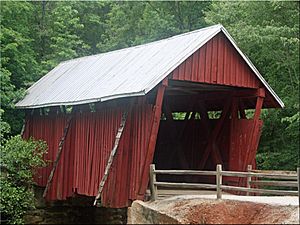Campbell's Covered Bridge facts for kids
Quick facts for kids Campbell's Covered Bridge |
|
|---|---|

A photo of Campbell's Covered Bridge near Gowensville, South Carolina.
|
|
| Coordinates | 35°5′9″N 82°15′51″W / 35.08583°N 82.26417°W |
| Carries | 123 Campbell Covered Bridge Rd. |
| Crosses | Beaverdam Creek |
| Locale | Gowensville, Greenville County, South Carolina |
| Characteristics | |
| Design | Covered bridge |
| Total length | 38 ft (12 m) |
| Width | 12 ft (3.7 m) |
| History | |
| Construction end | 1909 |
|
Campbell's Covered Bridge
|
|
| Lua error in Module:Location_map at line 420: attempt to index field 'wikibase' (a nil value). | |
| Location | 123 Campbell Covered Bridge Rd., Gowensville, South Carolina |
| Area | less than one acre |
| Built | 1909 |
| Architectural style | Howe truss |
| NRHP reference No. | 09000483 |
| Added to NRHP | July 1, 2009 |
Campbell's Covered Bridge is a special wooden bridge in Greenville County, South Carolina. It's near a small town called Gowensville. This bridge crosses a stream called Beaverdam Creek.
It's super important because it's the very last covered bridge left in all of South Carolina! Greenville County owns the bridge. They stopped cars from driving on it in the early 1980s. In 2009, it was added to the National Register of Historic Places. This means it's a really important historical site.
History of the Bridge
The Campbell's Covered Bridge was built in 1909. A man named Charles Irwin Willis built it. The bridge got its name from Alexander Lafayette Campbell. He owned a grist mill nearby. A grist mill is a place where grain, like corn, is ground into flour. Parts of his old mill are still there today.
The bridge has been fixed up two times. The first time was in 1964 by the Crescent Garden Club. It was fixed again in 1990.
The land around the bridge used to belong to Sylvia Pittman. In 2005, she sold about 10 acres (4 hectares) of land to Greenville County. She wanted everyone to enjoy the area, just like her family had. The money to start a park there came from state and county grants.
How the Bridge is Built
Campbell's Covered Bridge is 38 feet (11.6 meters) long. It is also 12 feet (3.7 meters) wide.
It was built using a special design called a Howe truss. This design uses vertical iron rods and diagonal pine timbers. This makes the bridge very strong.

